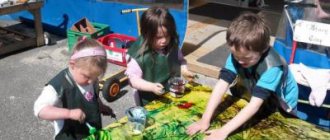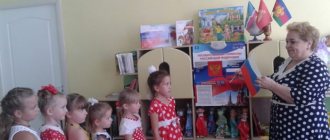What should children in the older group learn?
Consultation: “What a child should know and be able to do by the end of the senior group” consultation (senior group) on the topic
- Physical education. ...
- Natural surroundings. ...
- Speech development. ...
- Formation of elementary mathematical concepts. ...
- Fiction. ...
- Artistic and aesthetic education. ...
- Design and manual labor.
27 Feb
2022 Interesting materials:
What does staff mean in slang? What does a glass with a spoon mean in the microwave? What does Article 112 mean? What does the status of the case completed in the MFC mean? What does export status mean from the country of origin? What does processed status mean? What does the status of a parcel in Transit mean? What does the status of customs clearance Released by Customs mean? What does delivery status mean? What does in transit status mean?
How long can you study in kindergarten: Onishchenko’s advice
The question of how much can and should be done in a kindergarten or mini-kindergarten often worries parents. On the one hand, it is important that the child develops well. It especially pleases parents’ pride when a child is ahead of his peers in development. On the other hand, depriving a child of his childhood is criminal. Today we will talk about what the state thinks about classes in kindergarten and together we will read SanPiN 2.4.1.2660-10. “Sanitary and epidemiological requirements for the design, content and organization of the work regime in preschool organizations.”
This document was put into effect by a decree of the Chief State Sanitary Doctor Gennady Onishchenko. SanPiN is mandatory for compliance in preschool educational institutions, private kindergartens, mini-kindergartens and any other similar institutions.
So, for children aged 1.5 to 3 years, the duration of direct educational activity cannot exceed 1.5 hours a week and 10 minutes before lunch and after bedtime. As can be seen from the established standards, educational activities for the youngest children in kindergarten should be limited. Most of the time should be spent playing, outdoor games, exercise and sleep.
At older ages, the volume of permissible educational load in kindergarten increases. In the fourth year of life, it is permissible to study 2 hours 45 minutes per week, in the fifth - 4 hours, in the sixth - 6 hours 15 minutes, and finally in the preparatory group - 8 hours 30 minutes.
Also, at older ages, the duration of continuous educational activities has been increased: 15 minutes for the fourth year of life, 20 minutes for the fifth, 25 minutes for the sixth, 30 minutes for the preparatory group in kindergarten. The maximum load volume before lunch in the junior and middle groups must not exceed 30 and 40 minutes, respectively. For senior and preparatory groups, the educational load can be increased to 45 minutes and 1.5 hours, respectively. Classes must be interrupted by physical education, and breaks between classes must be at least 10 minutes.
Please note that in all cases mentioned above, we are talking about direct educational activities . If elements of educational activity are contained in games and physical activities, then this time is not taken into account when normalizing the load on a child in kindergarten.
Educational activities with children in kindergarten should be carried out in the first half of the day. Only with pupils of senior preschool age is it permissible to conduct classes after a nap. Although there are additional restrictions here too. They should take place a maximum of 2 - 3 times a week, last up to 25 - 30 minutes and must be interrupted by physical education.
Additional education in kindergarten is also regulated. The duration of classes in clubs, sections, studios is - for children of the 4th year of life - 1 time per week (no more) for up to 15 minutes; - for children 5 and 6 years of age - maximum 2 times a week for up to 25 minutes; — for children 7 years of age — 3 times a week, one lesson no more than 30 minutes.
Please note that the above standards do not only apply to activities where children sit at tables. You need to engage in physical education and creativity for at least 50% of the total time allotted for classes.
Finally, in kindergartens and mini-kindergartens there cannot be homework. Vacations should be provided for preschool children. During the holidays, only recreational and creative activities are allowed. Also during the holidays you should walk and move more.
If you are interested in the topic of SanPiN for preschool organizations, read the article “How many children per teacher should there be in a kindergarten: Onishchenko’s advice” on the website of the Teremok mini-kindergarten.
Examples of children's motivation for educational activities
According to the Federal State Educational Standard, educational activities with preschoolers should be based on the desire and voluntary participation of children. Various methods of motivating children help to fulfill this requirement. Motivation should not be artificial, divorced from previous activities of children, from the general mood that prevails in the group. In order to arouse a natural interest in the upcoming lesson in students, the teacher needs to know well what they are passionate about, what characters and fairy tale heroes they like, and respect their interests.
When offering children a new type of activity, the teacher must be emotional, sincere, and in a good mood, so that his positive attitude towards the lesson is transmitted to the kids. At the same time, you need to know when to stop: excessive display of emotions, a loud unnatural voice can overstimulate sensitive children and reduce interest. You can begin the introductory conversation in a subdued, mysterious tone. This reminds children of the beginning of a fairy tale, attracts their attention, and organizes it.
Table: examples of the motivating beginning of GCD in the middle group
The purpose and objectives of educational activities in the middle group of kindergarten
In the fifth year of a child’s life (middle group of kindergarten), physical and mental processes are rapidly developing. The baby’s actions become more accurate, coordinated, the ability to navigate in space, large and fine motor skills improves. Attention and memory move to a qualitatively new level and become voluntary, that is, the child can remember and reproduce the information that he needs and is interested in. Children master the first logical operations: searching for analogies, comparison, generalization, exclusion. Speech improves and becomes enriched. The child can make simple judgments not only about what he sees at the moment, but also when recalling certain events and imagining them.
Thus, three main tools for understanding the world are improved at once: movement, thinking and speech, which makes a child of this age a tireless explorer of the world around him. It’s not for nothing that the kids in the middle group are called little whys. But, in addition to an increased interest in their surroundings, four-year-olds are characterized by excessive emotionality, high mobility, restlessness, and absent-mindedness. After all, they want to be everywhere and at once, to explore and learn everything.
To direct the energy of fidgets in a useful and safe direction, the teacher of the middle group includes children in interesting and varied activities: outdoor and story games, musical and artistic creativity, familiarization with children's literature, household work, experimentation. These types of activities are carried out at different times of the day, in various forms, using rich visual material, paraphernalia, and folklore.
Four-year-old children are energetic and curious, and the teacher needs to direct these qualities to understanding the world around them in various types of activities.
Direct educational activity (DEA) or occupation is of great importance in the development of children. ECD is an activity specially organized by a teacher, aimed at solving certain educational problems.
The main goal of ECD is to streamline and systematize the process of assimilation of information by students, creating conditions for the most complete disclosure of the abilities and skills of each child. The tasks of GCD are varied and usually consist of 1-2 teaching, developmental and educational in accordance with the principle of the trinity of tasks in pedagogy. When planning a lesson, the teacher sets himself one main goal (what needs to be achieved during the lesson) and several ways to achieve it (tasks). Educational tasks are presented to the pupils in a playful way, taking into account the characteristics of their age: not “let’s learn to cut round shapes from a square with scissors”, but “let’s help the squirrel collect delicious apples for the mother squirrel in a basket.”
Walks and quiet time
These important components of the daycare routine are also age-appropriate.
Children from the early age group go for a walk earlier than others, at 9.00-9.30. The quiet hour has also been increased - babies sleep on average from 12.30 to 15.00.
Children from the senior group and the preparatory group go to a quiet hour at 13.00; their sleep lasts an average of 1.5 hours. They also have a shorter time to prepare for a walk - children at this age can already independently and quickly change clothes for playing in the fresh air.
However, regardless of age, quiet time in kindergartens ends at 15.00. After afternoon tea, the younger groups have a general education lesson; students from the middle and older groups are engaged in games or independent activities.
During the second walk, the children are gradually picked up by their parents. In winter, due to the fact that it gets dark quite early, the time for the second walk is reduced, and children are taken directly from kindergarten. Also, the walk may be shortened due to weather conditions: for example, frost or strong wind.
Games, joint and independent activities
Games and shared activities are very important for children. They teach children to communicate, develop creative thinking and imagination. During joint classes, a group of children completes tasks proposed by the teacher, thus preschoolers learn to work in a team and develop communication skills.
A total of three hours are allotted for independent games and activities, which allows the child to devote time to his own interests. Children play during the remaining time in such a tight schedule: before morning exercises, before and after classes, during walks.
Implementation of an individual approach
An individual or differentiated approach is successfully implemented in classes in all educational areas. So, during educational activities in mathematics or the formation of sound culture of speech, the teacher uses handouts: punched cards, cards with tasks of different levels of complexity, which makes the perception of the material understandable for each child. Those children who are faster than others can take another task card for themselves or help a friend.
In classes in fine arts and design, work in pairs and subgroups (3-4 people each) is used. Children, independently or with the help of a teacher, distribute and complete work in accordance with their own pace and abilities.
Drawing in pairs develops the ability to negotiate, and also allows children to come to the aid of a friend
Differentiation of tasks can also be carried out during a didactic game. For example, in a math class or learning about nature, you can use a game with a moth, an autumn leaf, or a snowflake. The teacher takes an image of an object and tells the game task: the one on whose shoulder or hand a moth (leaf, snowflake) sits will answer the question. Next, the teacher approaches several children in turn and asks them questions to consolidate what they have learned at different levels of complexity. Only a teacher who knows well the individual characteristics of children, their level of knowledge and abilities can conduct such a game. The game is also useful because it teaches children to listen carefully, not to interrupt, and to help a friend answer correctly.






